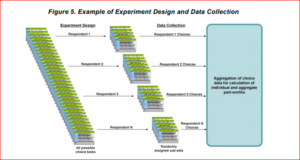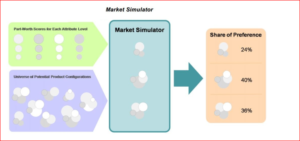Objective
The client was developing a new product with which he intended to gain shares of the existing market products. To help make the right kind of decisions, the client wanted to gain a clearer understanding of such issues as
– What are the options currently available?
– What share of the market do they have?
– What is the expected future usage for different product profile scenarios? Product profiles in this case mean combinations of various product options.
Approach
We conducted an online survey among current users our questionnaire aimed to gather the following information:

– details on the extent to which existing current product usage
– presenting the new product profile,
– future allocation in which the new product will be introduced alongside with existing product options
– possible choices based on the conjoint exercise module
In this study each customer was shown 12 hypothetical scenarios. Each scenario presented three different complete products each of which displayed different key product attributes in terms of levels of offers, price, payment options…etc . The customer was asked to choose the most preferred combination for each product profile
The philosophy behind the conjoint technique
The name ‘conjoint analysis’ implies the study of joint effects. In the case of marketing applications, we study multiple product attributes and evaluate their joint effects on the customer side. This type of analysis is used to measure consumer preferences of multi-feature product alternatives.

A conjoint analysis assumes that when a consumer makes a decision to purchase a product, this decision is based on trade-offs among various product characteristics. In other words, it’s likely that one single product will not satisfy the consumer in every way at a certain price, so the consumer has to decide which features they need or want the most and which they are prepared to trade-off.
Analysis of conjoint data yields a series of scores for each respondent at each attribute level. These scores, known as ‘part-worths’, are a measurement of the ‘utility’ that the consumer associates with a product and its attributes. Each score reflects the value that a respondent associates with each attribute level. Thus we are able to build a product and then calculate the value the consumer finds in that product. By comparing this outcome with other products on the market, we are able to gain a more precise understanding of how consumers actually decide which product to choose.
Outcome
The study enabled the client to:
– understand the relative importance of each product attributes.
– configure a formulation for the new product with combination of features.
– predict the potential share for the client’s product given the current competition.
– it gives an estimate of how many customers might switch from competition to the new product

Images Courtesy: w5insight.com



